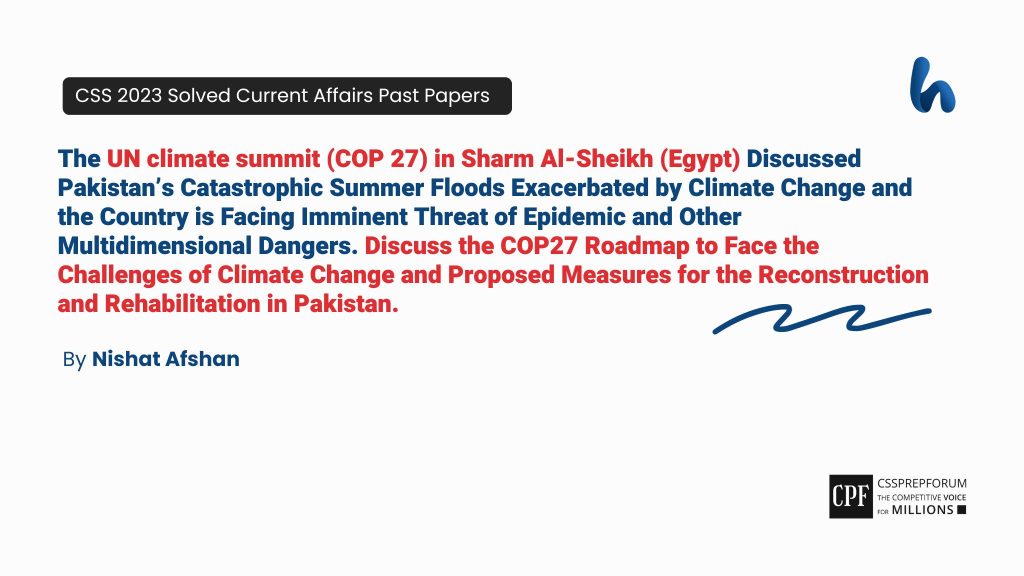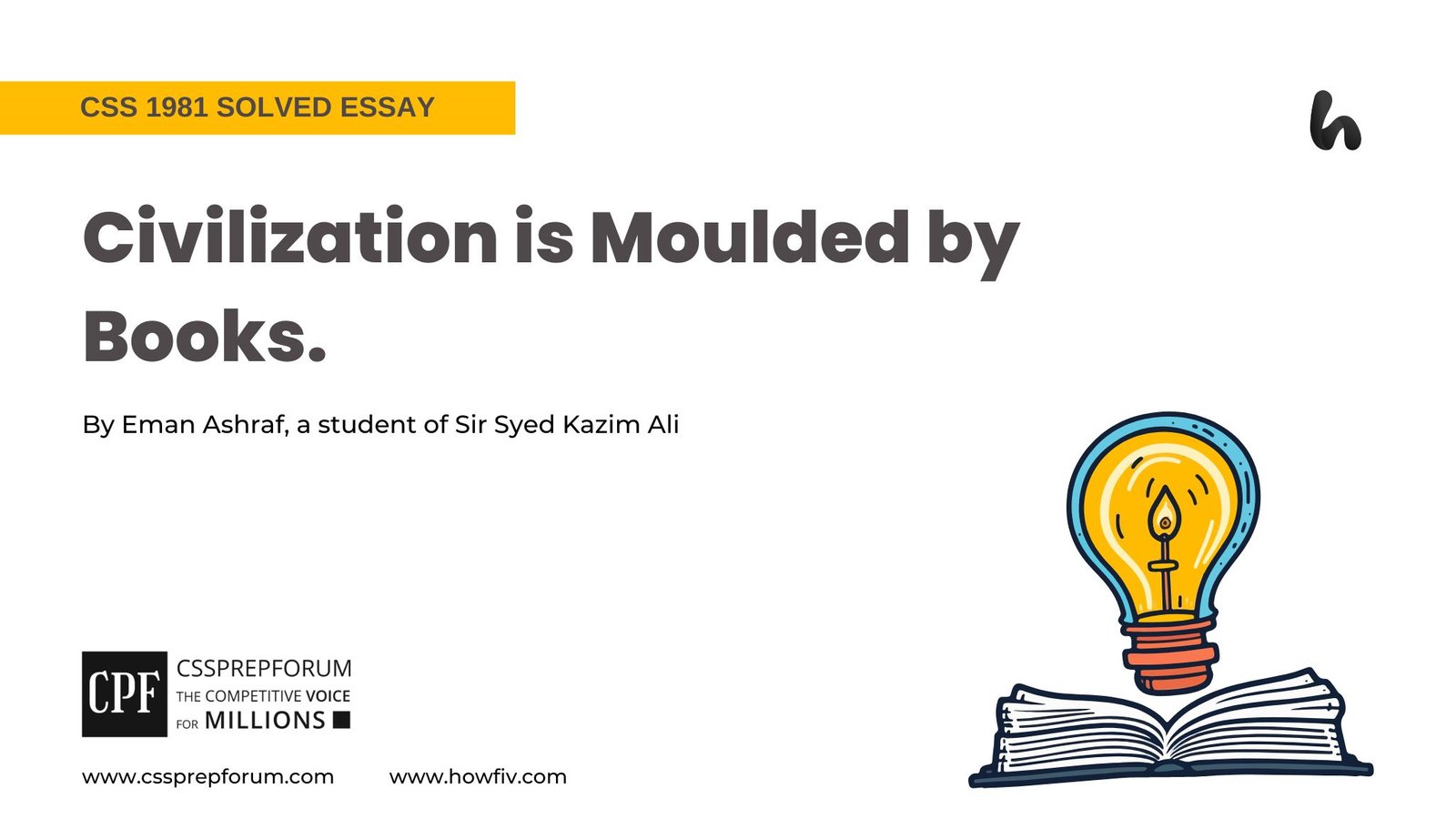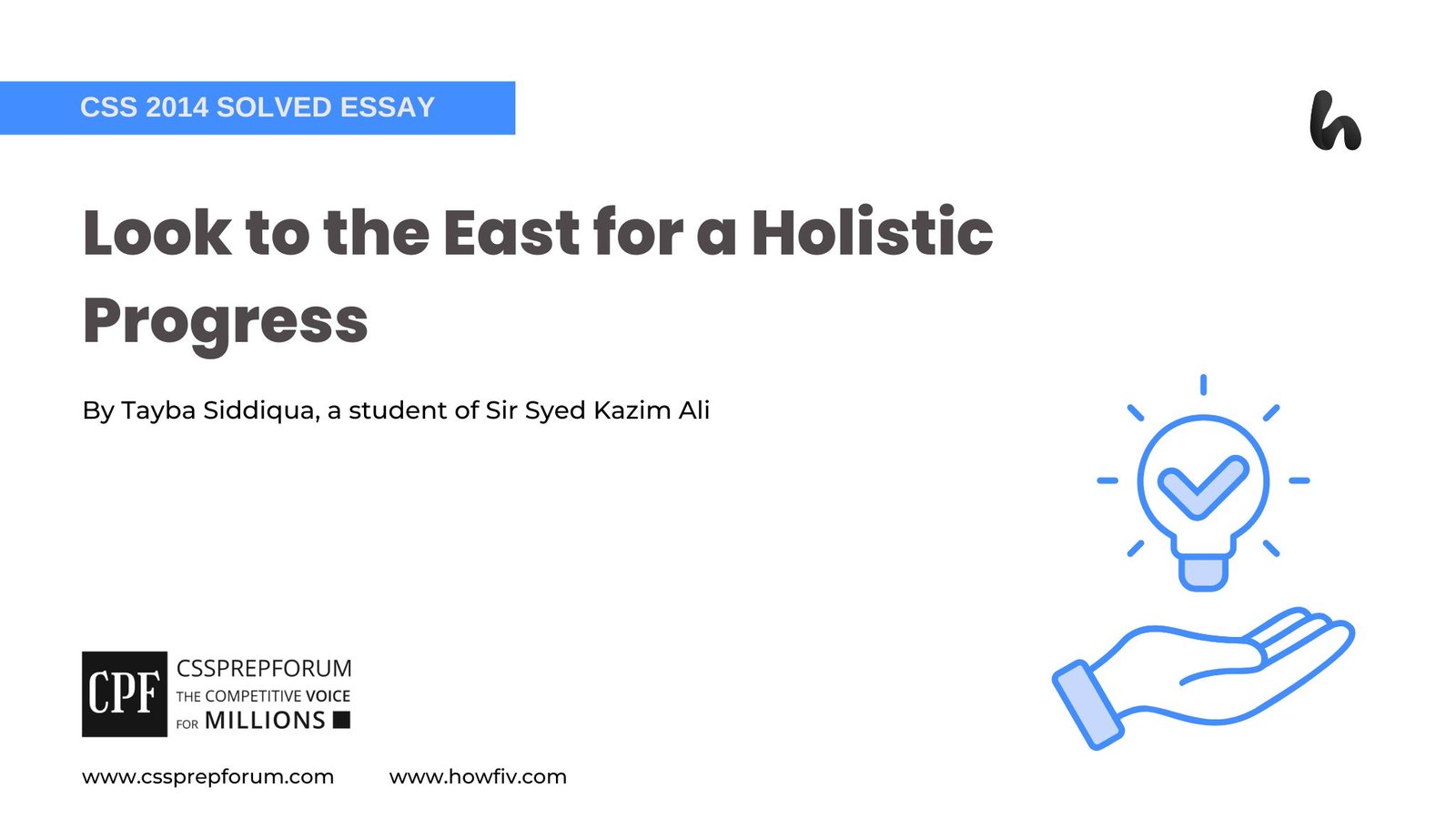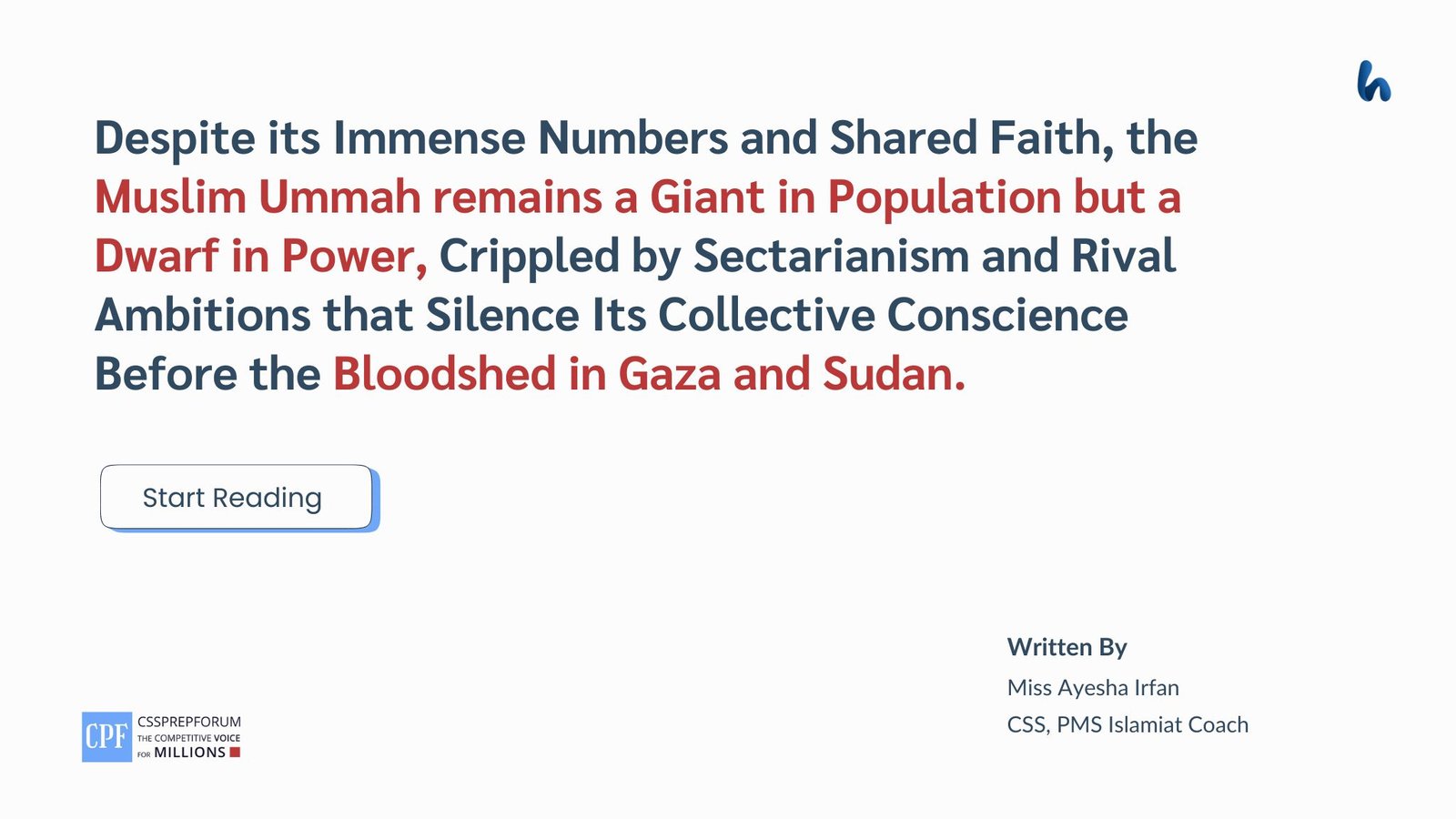CSS Solved Current Affairs Past Papers | The UN climate summit (COP 27) in Sharm Al-Sheikh (Egypt) Discussed Pakistan’s Catastrophic Summer Floods Exacerbated by Climate Change and the Country is Facing Imminent Threat of Epidemic and Other Multidimensional Dangers. Discuss the COP27 Roadmap to Face the Challenges of Climate Change and Proposed Measures for the Reconstruction and Rehabilitation in Pakistan.
The following question of CSS Current Affairs 2022 is solved by Nishat Afshan under the supervision of Miss Nirmal Hasni. She learnt how to attempt 20 marks question and essay writing from Sir Syed Kazim Ali, Pakistan’s best CSS and PMS English essay and precis teacher with the highest success rate of his students. This solved past paper question is attempted on the pattern taught by Sir to his students, scoring the highest marks in compulsory and optional subjects for years, and uploaded to help aspirants understand how to crack a topic or question, how to write relevantly, what coherence is, and how to include and connect ideas, opinions, and suggestions to score the maximum.

Question Breakdown:
In this question, the examiner has demanded two main things:
- COP 27 roadmap to face challenges of climate change
- Measures to be taken for the reconstruction and rehabilitation in Pakistan
Before hitting the main idea of the question, firstly, we have to take an overview of Pakistan’s catastrophic summer floods exacerbated by climate change and the imminent threats to Pakistan due to the disastrous floods of 2022. Then we will elaborate on the roadmap which has been provided at the UN climate summit COP 27 in Sharm Al-Sheikh and, finally a step towards multiprong strategies to be adopted for the reconstruction and rehabilitation in Pakistan.
Outline
1- Introduction
2- An overview of the 2022 floods in Pakistan and their catastrophic implications
3- A bird’s eye view of the COP-27 climate summit
4- Roadmap suggested by COP-27 to tackle challenges of climate change
- ✓Loss and damage fund
- ✓Emphasis on objectives of the Paris Agreement
- ✓Maintenance of temperature less than 2 degree Celsius
- ✓Phasing down fossil fuels
- ✓Shift towards renewables
- ✓Early warning system and technology
- ✓Nature and food
- ✓Protection of biotic components
- ✓Holding business and institutions to account
- ✓Trading carbon
- ✓Adaptation and mitigation strategy
5- Measures for the reconstruction and rehabilitation in Pakistan
- ✓Rebuilding damaged infrastructure
- ✓Building internal capacity
- ✓Establishment of a national flood response coordination center
- ✓Financial assistance to flood-affected people
- ✓Adaptation and mitigation strategy
- ✓4R Framework
- ✓Investment in an early warning system
- ✓Restore agricultural production
- ✓Maintenance of domestic and international trade to sustain food security
- ✓ “Build back better” approach
6- Critical analysis
7- Conclusion

Introduction
“The contours of the 21st century will be defined more importantly by a factor than any other, which is climate change. Climate change has become an existential threat to humanity”
(US former President Barack Obama)
Low-income nations have long been warned that rising temperature would hit their citizens the hardest, punishing the people who contributed the least to planet-warming emissions and have the fewest resources to cope. Now, as the floods in Pakistan and other recent disasters make the consequences of climate change impossible to ignore, the world is gearing up for a showdown over who should pay the costs. In this regard, Parties of Conference 27(COP 27), which took place in Egypt in 2022, also discussed the dilemma of climate change. Moreover, in COP 27, a roadmap was also formulated to cope with the challenges of climate change and to help developing nations in their struggle to combat climate change menace. The roadmap includes loss and damage fund, emphasis on objectives of the Paris Agreement, controlling temperature rise, phasing down non-renewables, and shifting towards renewable, to mention only a few. As Pakistan has already faced disastrous floods episode in 2010 and 2022, and many can come in the future so, Pakistan must take pertinent pragmatic measures for reconstruction and rehabilitation to mitigate the grave threats of climate change.
Floods-2022 in Pakistan: A Nightmare Scenario
After weeks of relentless rainfall, this summer in 2022 amid historic flooding that scientists say was supercharged by climate change. A scientific analysis of the disaster found that rainfall was made 50 to 75 per cent more intense, with the hardest-hit provinces experiencing their wettest months ever recorded, according to the study by the World Weather Attribution network.
- Pakistan consistently ranks among the top 10 countries worldwide most affected by climate change despite being a very small contributor to it, with under 1 per cent of global greenhouse gas emissions in 2018. (World Bank report)
- At least 1,700 people were killed, and 2 million homes were demolished by the floodwaters, according to Pakistan’s National Disaster Management Authority.
- Roads and bridges were washed away, thousands of schools were damaged, and some 7,000 square miles of farmland were ruined, triggering food shortages.
- The Economic and human cost of this Summer’s Floods is already stark. As of mid-October, 33 million people were affected by the floods, with 8 million estimated to have been displaced.
- And as Pakistan enters the recovery phase, the government estimates that over 9 million people could be pushed into poverty, with 19 of the 25 poorest districts in Pakistan deemed “calamity-affected.” Add in an estimated $30 billion in damages and economic losses, and the situation in Pakistan appears even more dire.
A Bird’s Eye View of COP 27 Climate Summit
The Conference of the Parties, or COP, is an annual meeting of world leaders, diplomats, and activists to discuss climate change. This year’s conference is the 27th such event and is being held over the course of two weeks in Sharm el-Sheikh, Egypt. In the negotiations, wealthier nations that disproportionately contribute to climate change agreed to establish a “loss and damage” fund.
Roadmap Suggested by Cop 27 to Tackle Climate Change:
A flurry of announcements was made, which include
- Loss and damage fund:
In COP 27 climate negotiations in Egypt, Pakistan will lead a bloc of more than 100 developing nations insisting on compensation for the irreversible harms of climate change, a class of impacts collectively known as “loss and damage.” The bloc has called for the creation of a dedicated loss-and-damage fund, which hard-hit countries can rely on for immediate assistance after a disaster, rather than waiting for humanitarian aid or loans that will drive them into debt. U.N. Secretary-General António Guterres said Thursday there is
“No more time to postpone the issue”
In September, Denmark announced a $13 million fund to assist vulnerable countries, the first U.N. member state to do so. This “loss and damage” fund will be a pot of money to help poorer nations recover from the impacts of climate change.
- Emphasis on objectives of the Paris Agreement:
Some countries proposed another tricky finance issue for inclusion on the agenda by making finance flows consistent with a pathway towards low greenhouse gas emissions and climate-resilient development under Article 2.1c of the Paris Agreement. There is the persistent question over whether developed countries are at last living up to their commitment to mobilize USD 100 billion in climate finance per year, a figure they were supposed to reach in 2020—and whether they are coming true on the goal of doubling adaptation finance. These discussions will, in turn, inform negotiations on the definition of a post-2025 collective climate finance goal.
- Maintenance of temperature within 1.5 degree
The 2015 Paris Agreement contained two temperature goals – to keep the rise “well below 2C” above pre-industrial levels and “pursuing efforts” to keep the increase to 1.5C. At Cop27, some countries tried to renege on the 1.5C goal and abolish the ratchet. Six years ago, countries were asked to make changes to keep global warming “well below” 2C – and to try to aim for 1.5C. Ahead of the conference, 200 countries were asked to submit new plans to cut emissions by 2030 to prevent temperatures rising by more than 1.5C. With these new plans, global temperatures are still expected to rise to 2.4C. So, the Egyptian COP President Sameha Shoukry wanted to focus on turning some of the more ambitious targets and pledges into tangible action.
- Shift toward renewables
The final text of Cop27 contained a provision to boost “low-emissions energy”. That could mean many things, from wind and solar farms to nuclear reactors and coal-fired power stations fitted with carbon capture and storage. It could also be interpreted to mean gas, which has lower emissions than coal but is still a major fossil fuel. Many countries at Cop27, particularly those from Africa with large reserves to exploit, came to Sharm el-Sheikh hoping to strike lucrative gas deals.
- Phasing down non-renewables
Last year at Glasgow, a commitment to phase down the use of coal was agreed. It marked the first time a resolution on fossil fuels had been included in the final text. At Cop27, some countries – led by India – wanted to go further and include a commitment to phase down all fossil fuels. That was the subject of intense wrangling late into Saturday night, but in the end, it failed, and the resolution included was the same as that in Glasgow.
- Early warning system and technology:
Longer term, the international community can also support comprehensive early warning systems and technologies to better gauge weather and rainfall patterns and ensure that this data can be used not just for predictive modelling, but also for better disaster preparedness and policy.
- Nature and food:
For the first time, the main agreement had specific sections on forests and “nature-based solutions”. The text also mentioned food for the first time and recognized how food shortages could continue to be driven by climate change. These are actions that protect or enhance the environment that also have climate benefits, for example restoring mangroves.
- Holding business and institutions to account
Net zero commitments can’t be a mere public relations exercise if we want to win the fight against climate change. We must have zero tolerance for greenwashing. The report from my Net-Zero Expert Group will help us move to the net-zero future we need:
- Protection of biotic components
By including new sections, leaders agreed that climate change, and efforts to protect plants and animals, should be complementary and not contradictory. Just weeks after COP27, governments met again in Montreal to agree on a “global goal for nature”. A call for a “peace pact with nature” was made.
- Trading carbon strategy
In 2021 in Glasgow, countries agreed to establish a global market for trading carbon. Simply put, this means that countries or companies that produce fewer emissions than their targets could “sell the carbon as a credit” to another country or company that has produced too many emissions. A smaller group of countries has been working on the issue for the past year and presented their recommendations in Sharm el-Sheikh at COP 27.
- Adaptation and mitigation strategy
Building flood defences, preserving wetlands, restoring mangrove swamps, and regrowing forests – these measures, and more, can help countries to become more resilient to the impacts of climate breakdown. But poor countries often struggle to gain funding for these efforts. Of the $100bn rich countries promised to help developing nations in adaptation measures, about $20bn goes to adaptation. In COP 27, it was reaffirmed that mitigation and adaptation strategies should be adopted.
Measures for Reconstruction and Rehabilitation in Pakistan
Pakistan needs to signal to the international community that Pakistan is serious about addressing its climate change crisis and, if large-scale assistance or a debt-for-climate swap is provided, that there would not be a change in policy from one government to the next in recovery and rehabilitation efforts. The following measures should be taken on an urgent note
- Rebuilding damaged infrastructure:
Rebuilding damaged infrastructure in a resilient way is a dire need of the hour. Although it will cost the country more than $16 billion, the World Bank said — a bill the cash-strapped nation can ill afford to pay, Pakistan has to do it on an urgent basis. The world has to help Pakistan without any delay.
“There is no way anyone can argue there is no loss and no damage. The world must come together to support developing countries including Pakistan and other vulnerable communities.”
U.N. Secretary General
- Building of internal capacity
A blank check for purely development assistance will not help Pakistan. The Pakistani state, at all levels, needs to focus on longer-term technical assistance and build its internal capacity to create resilience to future natural disasters. To some degree, Pakistan has laid the groundwork already. The most recent National Security Policy (NSP) included action against climate change as a component of human security. However, the NSP narrowly defined climate change by connecting it with water security and Food security.
- Establishment of a national flood response coordination center
To address its overarching climate change challenge, the Pakistani government recently established the National Flood Response Coordination Center (NFRCC). The NFRCC is tasked with ensuring coordination across various agencies involved in both the flood response and rehabilitation efforts, as well as working with international donors and non-governmental organizations on relief. If Pakistan is to capitalize on its opportunity at COP27 and beyond, the state must show a willingness to strengthen established institutions, including the National Disaster Management Authority, National Disaster Risk Management Fund, and the District Disaster Management Authorities across the country.
- Adaptation and mitigation strategy
Moving forward, the Pakistani government must develop a roadmap for sweeping internal reforms when it comes to climate change preparedness and identify key entry points for the international community to support Pakistan’s efforts to adapt to and mitigate the impacts of climate change. In order to minimize the destruction caused by floods, there is a need for more plantation projects like the “billion tree tsunami project”.
- Financial assistance to flood-affected people
There is a need to include key affected sectors in large-scale disaster response and involve all affected stakeholders. In addition, even if emergency food relief is provided, continuing access to food remains a concern, given the widespread destruction of wealth and interruptions in income—the classic “entitlement problem” outlined by Amartya Sen. The destruction of livelihoods mandates complementary interventions of food and cash transfers and enhanced flow of formal credit during and after disasters. The betterment of livelihoods should be a central focus in recovery and rehabilitation plans in Pakistan.
- Investment in early warning systems
Flooding of this magnitude has revealed the lack of investment in early warning systems and more generally in disaster planning; for example, many people live in danger zones exposed to flooding and other hazards. While an early warning system may not avert a crisis, it could still save many lives and minimize economic losses. After the 2010 floods, the government did announce new monitoring systems for glacier melt and floods for tributaries of the Indus, working with disaster management authorities and the World Wildlife Fund (WWF), it also organized training on community-based early warning systems.
- Restore agricultural production
The 2010 IFPRI research determined that the provision of seeds to smallholders and landless, along with the replenishment of livestock assets, were important components of the recovery program. The study also identified the important role of NGOs in providing access to microcredit and in creating channels for emergency supplies needed for restoration. The United States and the international community can play an immediate role in the provision of seeds that are high-yield and drought- and flood-resistant, as well as more cooperation on improved agricultural practices now that we are in the planting season.
- Maintenance of domestic and international trade to sustain food security
There is a crunch need to maintain domestic and international trade to sustain food security and nutrition. Rebuilding trade-related infrastructure and trade policies that provide incentives for the private sector should be prioritized not only for agricultural staples but also for inputs, including equipment and machinery. Pakistan gained from trade after the 2010 floods when imports helped stabilize market prices at import parity levels without creating an additional government spending burden, an important concern given the current macroeconomic situation in Pakistan. Such measures must be taken again to combat the aftermaths of disasters.
- 4R framework
The goal of preparing the Resilient Recovery, Rehabilitation, and Reconstruction Framework (4RF) is to ensure that transformational measures are put into place to ensure resilient recovery and to reduce the impact on developmental gains so as not to hinder the progress of future generations. It also provides a foundation on which the country will build and strengthen long-term resilience to climate-induced disasters. The 4RF document suggests effective coordination and participation arrangements among federal and provincial governments, development partners, donors, international and national NGOs, academia, the private sector, and communities. Importantly, the 4RF is a living document that can be updated regularly as priorities and resources change. It thus forms the basis for the Monitoring and Evaluation of the recovery program.
- “Build back better” approach
Key policy imperatives include a community-driven and ‘people-centred’ approach, promotion of equality and opportunities for the poorest households, women, and other vulnerable and marginalized groups disproportionately impacted by the floods, employment of rapid and efficient recovery mechanisms, incorporation of green and resilient principles through a ‘build back better’ approach, and risk-informed resilience, etc.
Critical Analysis
Climate change has become a reality, and it is posing grave threats to all states across the globe with the exception of no one. Recent floods in Pakistan are a horror glimpse of climate change which has caused catastrophic damage of more than 30 billion dollars. Although the world is trying to focus on this issue of climate change, but still ignorance of states is there which can create a more alarming situation for all of us. There is no action regarding the Paris Agreement and even in COP27, different countries are showing reluctance towards the action plan of the Parties of Conference. Although a loss and damage fund has been created in COP27, there is no agreement yet on how the finance should be provided and where it should come from. However, the roadmap provided by the COP27 can act as a volte’s face, if it is implemented pragmatically by the mutual collaboration of all the states of the world.
Conclusion
We are already living in a 1.1°C warmer world. Given current emissions trends, the kind of devastating floods that hit Pakistan in 2022 will grow in both frequency and intensity as the world approaches 1.5°C of warming in a decade; a climate-destabilized future is not far away. The question to ask now in the aftermath of the Pakistan floods is not only what the government and citizens of Pakistan can do. More importantly, it’s what the international community, and especially the historical emitters that have caused current climate change can do to reduce emissions, and to create Loss and Damage mechanisms for climate compensation. Investments must also give priority to improving disaster response and building climate resilience. Pakistan has suffered a grievous blow, but how the country and world respond going forward can help chart a course toward a more equitable global approach to climate impacts, and for blunting the effects of future disasters on the most vulnerable countries. The floods in Pakistan can be the spur for countries to work together at COP27 and accelerate collective climate action.
CSS Solved Past Papers’ Essays
Looking for the last ten years of CSS and PMS Solved Essays and want to know how Sir Kazim’s students write and score the highest marks in the essays’ papers? Then, click on the CSS Solved Essays to start reading them.
CSS Solved Essays
CSS 2023 Solved Current Affairs

Articles Might Interest You!
The following are some of the most important articles for CSS and PMS aspirants. Click on any to start reading.












